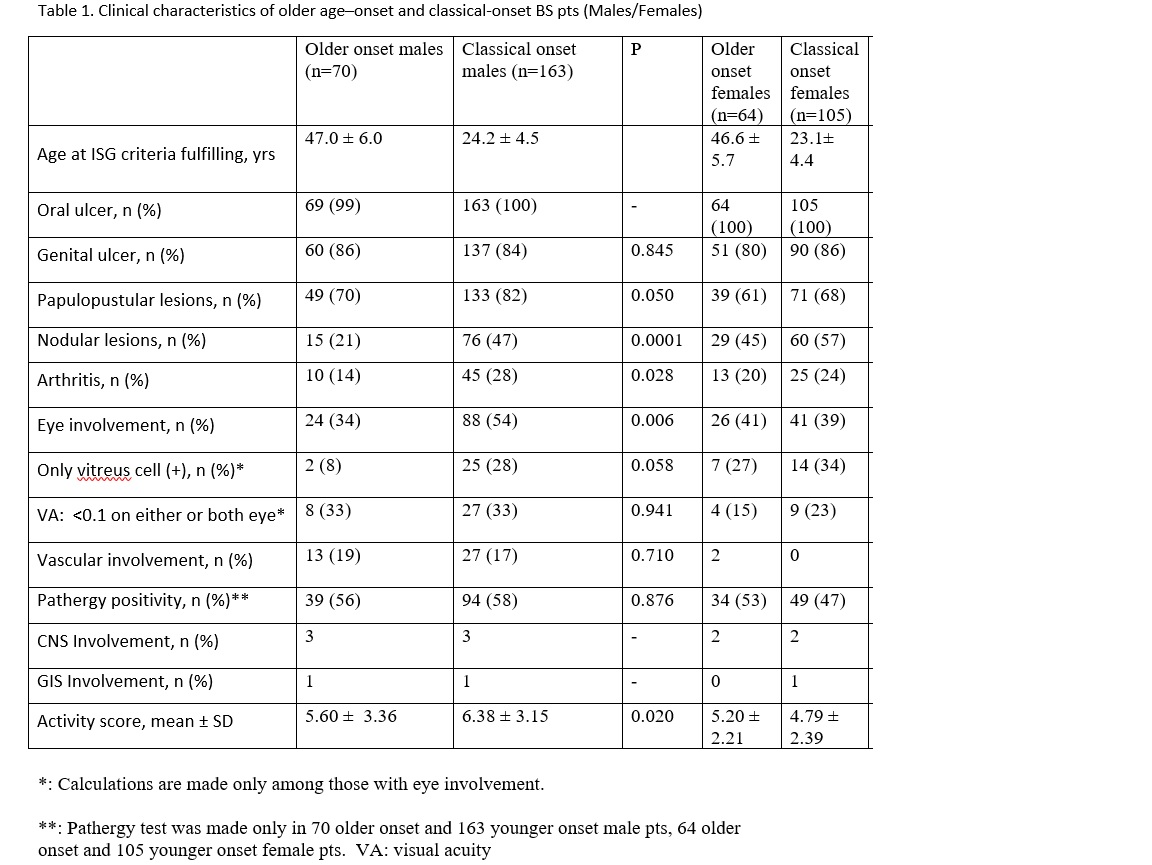Session Information
Date: Monday, October 22, 2018
Title: Vasculitis Poster II: Behҫet’s Disease and IgG4-Related Disease
Session Type: ACR Poster Session B
Session Time: 9:00AM-11:00AM
Background/Purpose: The usual onset of Behçet syndrome (BS) is in the 3. decade. Older age-onset defined as fulfilling the International Study Group (ISG) criteria after 40 years (yrs) of age is rare and our knowledge about it is limited. One early study from our center had reported the severity of eye disease was not different between early onset (≤24 yrs) and late onset (≥25 yrs) group, while the total clinical activity scores were smaller in the late onset group (1). While there is ambiguity in the definition of older onset, a few case series (2-4) coming mostly from ophthalmology or dermatology settings describe a similar or less severe clinical picture among late onset patients (pts) compared to that seen in early onset. The aim of this retrospective study was to evaluate clinical characteristics of pts with older onset BS pts, to compare them with a group of classic onset BS pts.
Methods: The charts of 3335 BS pts who were registered between Jan 2000 and Dec 2010 were reviewed retrospectively. Pts who fulfilled the ISG criteria for BS after 40 yrs of age (≥ 40) were defined as older onset, while those who fulfilled the criteria before 30 yrs of age as classic onset. For each older onset chart, 2 consecutively registered early onset charts were selected. Only clinical manifestations at initial presentation were recorded. A clinical activity index (1) was modified, calculated for each pt.
Results: There were only 134(70 M/64 F) pts with older onset BS, which gave a prevalence of 4% in the whole cohort. Age of onset was 40-44 yrs of age in 54 pts, 45-49 yrs in 47 and 50+ in 32. As controls 268(163 M/105 F) classic onset pts were selected. Demographic/Clinical characteristics among older and classic onset pts are described for males and females separately, in Table. The frequency of skin manifestations, arthritis and eye disease as well as the mean clinical activity scores were significantly higher among male classic onset pts compared to older onset male pts. Interestingly, frequency of those with positive pathergy test, vascular involvement and severe eye involvement did not seem to be different among older onset and classic onset male pts. Clinical characteristics and total activity scores were similar between the older onset and classic onset groups among females (Table). The main limitation is that the information was based solely on patient’s charts and outcome information was not available.
Conclusion: Compared to classic onset pts, males tend to be less frequent in the older cohort. At presentation, older onset male pts had significantly less frequent skin, joint, eye disease, and significantly lower total activity scores compared with classic onset pts. There was no difference between the classic and older onset group, among females.
References: 1-Yazici H et al.Ann Rheum Dis.1984.2-Tsai J et al.J Eur Acad Dermatol Venereol.2008.3-Hamzaoui A et al.Acta Medica Iranica 2014.4-Citirik M et al.Ophthalmologica.2011.
To cite this abstract in AMA style:
Guzelant G, Ozyazgan Y, Mat C, Hamuryudan V, Yazici H, Seyahi E. Clinical Characteristics of Older Age-Onset Behçet Syndrome Patients [abstract]. Arthritis Rheumatol. 2018; 70 (suppl 9). https://acrabstracts.org/abstract/clinical-characteristics-of-older-age-onset-behcet-syndrome-patients/. Accessed .« Back to 2018 ACR/ARHP Annual Meeting
ACR Meeting Abstracts - https://acrabstracts.org/abstract/clinical-characteristics-of-older-age-onset-behcet-syndrome-patients/

